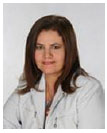Márcia Beatriz Tartarella1; Rosane Cruz Ferreira2; Islane Maria de Castro Verçosa3; João Borges Fortes Filho4
DOI: 10.17545/e-oftalmo.cbo/2016.60
ABSTRACT
Uncorrected refractive errors in children may generate abnormalities in visual function and affect their future academic studies, as well as their neuromotor development. Refractive errors are easy to diagnose and correct. An ophthalmologic examination with visual acuity measurements should be performed to arrive at a diagnosis of refractive error. Lenses should then be prescribed which could minimize these serious consequences for childhood development.
Keywords: Refraction; Ocular; Child.
RESUMO
Defeitos refrativos não corrigidos em crianças podem gerar alterações nas funções visuais e afetar sua educação acadêmica futura bem como o seu desenvolvimento neuropsicomotor. Erros refrativos são de fácil diagnóstico e correção. Deve ser realizado exame oftalmológico com testes de medição de acuidade visual, diagnóstico dos defeitos refrativos e a prescrição das lentes adequadas para minimizar essas importantes consequências no desenvolvimento da criança.
Palavras-chave: Refração Ocular: Criança.
INTRODUCTION
Uncorrected refractive errors in children may generate abnormalities in visual function and may seriously affect their future academic studies, as well as their neuromotor development.
Refractive errors are easy to diagnose and correct. An ophthalmologic examination with visual acuity measurements should be performed to arrive at a diagnosis of refractive error. Lenses should then be prescribed which could minimize these serious consequences for childhood development.
Data from the International Agency for the Prevention of Blindness (IAPB) show that low visual acuity may affect approximately 5.5% of school-aged children, and that 80% of cases of low visual acuity in school-aged children can be corrected with eyeglasses alone.1 A variety of previous studies, including many performed in different regions of Brazil, corroborate this international finding and reflect the need for refractive error to be addressed properly among Brazilian children. 2, 3, 4, 5, 6, 7, 8
In 2007, the Brazilian Pediatric Ophthalmology Society (SBOP) performed a survey among its members and came to a consensus regarding prescription eyeglasses for preverbal children (defined as 0 to 3 years of age). The recommendations below are based upon studies referred to by the American Academy of Ophthalmology, and have been adapted for Brazil by the SBOP.9
RECOMMENDATIONS
The SBOP suggests that eyeglasses be prescribed to preverbal children in the following cases:
1. Children with myopia (without anisometropia)
• Children between 0 and 1 year of age: correct errors of -4.00 D or greater
• Children between 1 and 2 years of age: correct errors of -3.00 D or greater
• Children between 2 and 3 years of age: correct errors of -2.50 D or greater
2. Children with hypermetropy (ortophoric and without anisometropia)
• Children between 0 and 1 year of age: correct errors of +6.00 D or greater
• Children between 1 and 2 years of age: correct errors of +5.00 D or greater
• Children between 2 and 3 years of age: correct errors of +5.00 D or greater
• Reduce final prescription from 1.00 to 2.00 D
3. Children with hypermetropy (with accommodative esotropia of approximately 30 prism diopters)
• Children between 0 and 1 year of age: correct errors greater than +2.00 D
• Children between 1 and 2 years of age: correct errors greater than +2.00 D
• Children between 2 and 3 years of age: correct errors greater than +1.50 D
• Prescribe the entire refractive error in cases of cycloplegia. If this is greater than 3.00 D, the final refractive error can be reduced by 0.50 D.
4. Children with astigmatism (without anisometropia)
• Children between 0 and 1 year of age: correct errors greater than 2.50 D
• Children between 1 and 2 years of age: correct errors greater than 2.50 D
• Children between 2 and 3 years of age: correct errors greater than 2.00 D
5. Children with hypermetropic anisometropia
• Children between 0 and 1 year of age: correct errors of +2.00 D or greater
• Children between 1 and 2 years of age: correct errors of +1.50 D or greater
• Children between 2 and 3 years of age: correct errors of +1.50 D or greater
6. Children with myopic anisometropia
• Children between 0 and 1 year of age: correct errors of -2.50 D or greater
• Children between 1 and 2 years of age: correct errors of -2.50 D or greater
• Children between 2 and 3 years of age: correct errors of -2.50 D or greater
7. Children with astigmatic anisometropia
• Children between 0 and 1 year of age: correct errors of 2.00 D or greater
• Children between 1 and 2 years of age: correct errors of 1.50 D or greater
• Children between 2 and 3 years of age: correct errors of 1.50 D or greater
OTHER RECOMMENDATIONS
• The use of unbreakable hardened (polycarbonate) lenses is recommended for children with monocular vision, even in cases without refractive error. This will minimize risks of trauma to the only seeing eye.
• Children older than four years of age can participate in subjective tests to decide the best correction to be prescribed.
• These recommendations or suggestions may be modified on a case by case basis and always depending on the rest of the patient's clinical data.
• In patients with refractive amblyopia (which affects 1 % to 4% of the population), the error should be treated with eyeglasses and occlusion therapy (as per the patching protocol) until 10 years of age.
• In patients with oblique astigmatism, which further compromises visual development, errors of 1.50 D or greater should be corrected.
• Children's eyes should also be protected by the use of eyeglasses with filters that protect against the phototoxicity generated by UVA/UVB radiation from both the atmosphere and devices which emit electromagnetic waves, such as computers, TVs, cell phones, laptops, microwaves, indoor lighting (cold or blue spectrum lights), and other common electronic equipment. This protection should be encouraged by ophthalmologists, who should make parents and guardians aware of the fact that this exposure may cause the formation of early cataracts and may also predispose patients to age-related macular degeneration (ARMD).10,11
REFERENCES
1. Barria Von-B F, Silva JC, Carrillo RE. Guía clínica de refracción en el niño. 2014 [citado Fev 2017]. Disponível em: http://www.v2020la.org/images/Guia_Refraccion_en_el_nino.pdf
2. Albuquerque RC, Alves JGB. Afecções oculares prevalentes em crianças de baixa renda atendidas em um serviço oftalmológico na cidade do Recife - PE, Brasil. Arq Bras Oftalmol. 2003;66(6):831-4. Disponível em: http://www.scielo.br/scielo.php?script=sci_arttext&pid=S0004-27492003000700017&lng=en. http://dx.doi.org/10.1590/S0004-27492003000700017
3. Lopes GJA, Casella AMB, Chuí CA. Prevalência de acuidade visual reduzida nos alunos da primeira série do ensino fundamental das redes pública estadual e privada de Londrina-PR, no ano de 2000. Arq Bras Oftalmol. 2002;65:659-64. Disponível em: http://www.scielo.br/scielo.php?script=sci_arttext&pid=S0004-27492002000600012&lng=en. http://dx.doi.org/10.1590/S0004-27492002000600012
4. Oliveira CAS, Hisatomi KS, Leite CP, Schellini SA, Padovani CR. Erros de refração como causas de baixa visual em crianças da rede de escolas públicas da regional de Botucatu - SP. Arq Bras Oftalmol. 2009;72(2):194-8. Disponível em: http://www.scielo.br/scielo.php?script=sci_arttext&pid=S0004-27492009000200012&lng=en. http://dx.doi.org/10.1590/S0004-27492009000200012
5. Portes AJF, Portes ALF, Bonfadini CG, Shinzato FA, Pecego MG, Borges da Silva ASS. Prevenção à cegueira em crianças de três a seis anos de idade assistidas pelo Programa de Saúde da Família-Lapa, Rio de Janeiro. Rev Bras Oftalmol. 2007;66 (3):155-9. Disponível em; http://www.iorj.med.br/downloads/5_prevencao_cegueira_em_criancas%20(1).pdf
6. Araújo AL, Zucchetto NM, Fortes Filho JB. Campanhas de promoção de saúde ocular: experiência do Hospital Banco de Olhos de Porto Alegre. Rev Bras Oftalmol. 2007;66(4):231-5. Disponível em: http://www.scielo.br/scielo.php?script=sci_arttext&pid=S0034-72802007000400003&lng=en. http://dx.doi.org/10.1590/S0034-72802007000400003
7. Lemos LEC, Pinheiro Júnior MN. Erros refracionais e sua influência no aprendizado de jovens escolares da Cidade de Manaus. Rev Bras Oftalmol. 2002;61(4):268-76. Resumo disponível em: http://bases.bireme.br/cgi-bin/wxislind.exe/iah/online/?IsisScript=iah/iah.xis&src=google&base=LILACS&lang=p&nextAction=lnk&exprSearch=317949&indexSearch=ID
8. Gaete MIL, Lira RPC, Moraes LFL, Vasconcelos MSL, Oliveira CV. Associação entre a necessidade de prescrição de correção óptica e outras doenças oculares em crianças na idade escolar. Arq Bras Oftalmol. 2007;70(6):949-52. Disponível em: http://www.scielo.br/scielo.php?script=sci_arttext&pid=S0004-27492007000600012&lng=en. http://dx.doi.org/10.1590/S0004-27492007000600012
9. American Academy of Ophthalmology. Refractive errors in children [Internet]. 2014 [citado Fev. 2017]. Disponível em: http://www.aao.org/SearchResults.aspx?q=refractive%20errors%20in%20children&c=1
10. Lobo Ferreira JL. Proteção ocular da radiação solar [Internet]. 2010 [citado Fev 2017]. Disponível em; http://www.portaldaoftalmologia.com.br/index.php?option=com_content&view=article&id=93:protecao-ocular-da-radiacao-solar&catid=46:artigos&Itemid=68
11. World Society of Paediatric Ophthalmology & Strabismus. Consensus statement on: sunlight exposure and childrens' eyes [Internet] [citado Fev 2017]. Disponível em: http://wspos.org/wp-content/uploads/2015/04/WSPOS_Consensus-Statement booklet.pdf



Source of funding: None declared
Conflict of interests: None declared
Received on:
October 1, 2016.
Accepted on:
October 11, 2016.